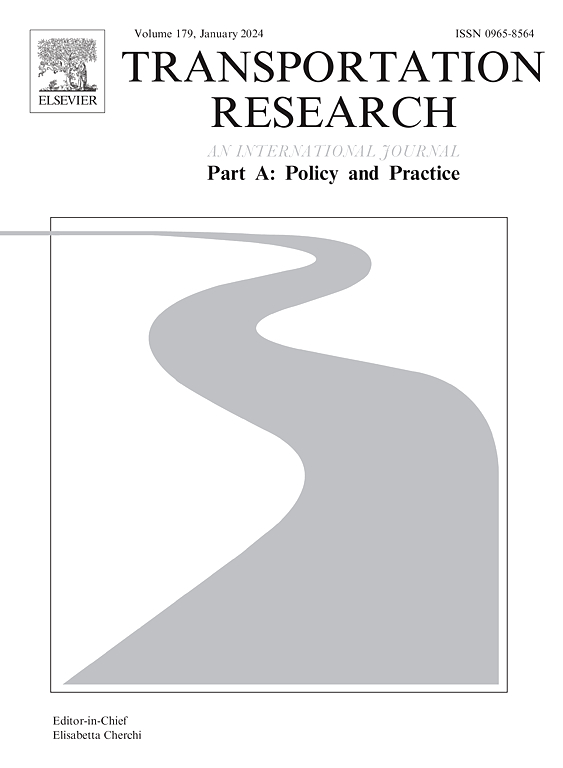Quantitative analysis of the relationships between dockless bike sharing and public transport: A trip-level perspective
IF 6.3
1区 工程技术
Q1 ECONOMICS
Transportation Research Part A-Policy and Practice
Pub Date : 2024-10-13
DOI:10.1016/j.tra.2024.104277
引用次数: 0
Abstract
The widespread expansion of dockless bike sharing (DBS) services has had non-negligible effects on public transport systems by establishing intricate connections with public transport modes, such as metro and bus. An accurate understanding of the intricate relationships between DBS and public transport is crucial for promoting synergistic operations and maximizing the benefits. This study presents a novel quantitative analysis methodology from a trip-level perspective based on multi-source data to explore the relationships between dockless bike sharing and public transport without reliance on geospatial thresholds. By utilizing a comprehensive dataset encompassing bike sharing service operations, public transit facilities, and optimal route choices, we introduce the concepts of degree of site proximity (DSP) and degree of trip substitution (DTS), which are designed to assess the opportunities for cooperation and competition in DBS trips. Clustering techniques categorize recorded trips into specific types: competition, cooperation, cooperation-competition, and independence. A survey of dockless bike sharing users in Shanghai, China was conducted to obtain data on usage of DBS and the alternative choices without DBS. A comparison between the survey results and the estimates from the proposed methodology validates its effectiveness. In-depth analyses of factors such as weekends, cycling distances, and station densities reveal patterns of variation in the relationship between DBS and public transport systems. These findings provide valuable insights for urban planners and policymakers to enhance the integration of DBS and public transport systems, thereby improving the overall efficiency and sustainability of urban transportation networks.
无桩共享单车与公共交通之间关系的定量分析:出行层面的视角
无桩共享单车(DBS)服务的广泛推广,通过与地铁和公交车等公共交通工具建立错综复杂的联系,对公共交通系统产生了不可忽视的影响。准确理解无桩共享单车与公共交通之间错综复杂的关系,对于促进协同运营、实现效益最大化至关重要。本研究基于多源数据,从出行层面的角度提出了一种新颖的定量分析方法,以探讨无桩共享单车与公共交通之间的关系,而无需依赖地理空间阈值。通过利用涵盖共享单车服务运营、公共交通设施和最优路线选择的综合数据集,我们引入了站点邻近度(DSP)和出行替代度(DTS)的概念,旨在评估无桩共享单车出行中的合作与竞争机会。聚类技术将记录的出行分为特定类型:竞争、合作、合作-竞争和独立。我们对中国上海的无桩共享单车用户进行了一项调查,以获得有关使用 DBS 和不使用 DBS 的其他选择的数据。调查结果与建议方法的估计值之间的比较验证了该方法的有效性。对周末、骑行距离和站点密度等因素的深入分析揭示了 DBS 与公共交通系统之间关系的变化模式。这些研究结果为城市规划者和政策制定者提供了宝贵的见解,有助于他们加强 DBS 与公共交通系统的整合,从而提高城市交通网络的整体效率和可持续性。
本文章由计算机程序翻译,如有差异,请以英文原文为准。
求助全文
约1分钟内获得全文
求助全文
来源期刊
CiteScore
13.20
自引率
7.80%
发文量
257
审稿时长
9.8 months
期刊介绍:
Transportation Research: Part A contains papers of general interest in all passenger and freight transportation modes: policy analysis, formulation and evaluation; planning; interaction with the political, socioeconomic and physical environment; design, management and evaluation of transportation systems. Topics are approached from any discipline or perspective: economics, engineering, sociology, psychology, etc. Case studies, survey and expository papers are included, as are articles which contribute to unification of the field, or to an understanding of the comparative aspects of different systems. Papers which assess the scope for technological innovation within a social or political framework are also published. The journal is international, and places equal emphasis on the problems of industrialized and non-industrialized regions.
Part A''s aims and scope are complementary to Transportation Research Part B: Methodological, Part C: Emerging Technologies and Part D: Transport and Environment. Part E: Logistics and Transportation Review. Part F: Traffic Psychology and Behaviour. The complete set forms the most cohesive and comprehensive reference of current research in transportation science.

 求助内容:
求助内容: 应助结果提醒方式:
应助结果提醒方式:


